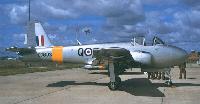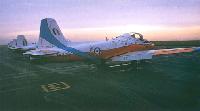Фотографии
-
Регистрационный номер: XP547 Hunting Jet Provost T.4 XP547 '03' of 79 Squadron, 'C' Flight 1 Tactical Weapon Unit, Brawdy, in 1983. Dark Green, Dark Sea Grey with Light Aircraft Grey under surfaces. Red/blue tactical roundels.
Самолёты на фотографии: Hunting Percival Jet Provost / P.84 - Великобритания - 1954
-
Регистрационный номер: XD677 Hunting Jet Provost T.1 XD677 'M-Q' of 2 Flying Training School, Syerston, circa 1959. Silver overall with 24in (60.9cm) yellow 'Trainer' bands on fuselage and wings. Code letters approximately 16in. Note: Common to all the artwork: Roundels: fuselage 18in, wings 30in, fin flash 18 x 24in. Serials: Fuselage 8in; underwing 24in.
Самолёты на фотографии: Hunting Percival Jet Provost / P.84 - Великобритания - 1954
-
Регистрационный номер: XM411 Hunting Jet Provost T.3 XM411 'R-G' of the Central Flying School, Little Rissington, circa early 1960s. Aluminium with yellow Day-Glo areas.
Самолёты на фотографии: Hunting Percival Jet Provost / P.84 - Великобритания - 1954
-
Регистрационный номер: XP583 Hunting Jet Provost T.4 XP583 '87' of RAF College, Cranwell. Red and white fuselage with red and Light Aircraft Grey wings. Dark and light blue 'Cranwell' band with RAF College crest on fuselage. With the exception of the College band, this was the common finish for the remainder of the aircraft's service.
Самолёты на фотографии: Hunting Percival Jet Provost / P.84 - Великобритания - 1954
-
Регистрационный номер: XW370 Hunting (BAC) Jet Provost T.5 XW370 of 'The Swords' aerobatic team, 3 Flying Training School, Leeming. Red and white fuselage with red and Light Aircraft Grey wings. Name in gold script on the intake.
Самолёты на фотографии: Hunting Percival Jet Provost / P.84 - Великобритания - 1954
-
Регистрационный номер: XP669 Hunting Jet Provost T.4 XP669 '37' of 2 Flying Training School, Syerston, circa late 1960s. Aluminium with 8in wide red Day-Glo panels.
Самолёты на фотографии: Hunting Percival Jet Provost / P.84 - Великобритания - 1954
-
Регистрационный номер: XM424, XM466 T.3s XM424 and XM466 showing off the attractive display colour scheme of 1 FTS, Linton-on-Ouse, Yorkshire, 1992.
Самолёты на фотографии: Hunting Percival Jet Provost / P.84 - Великобритания - 1954
-
Регистрационный номер: XW330 On September 3, 1969, the CFS received the first of the new BAC Jet Provost T.5s for the RAF, XW287. The T.5 featured a pressurised cockpit to allow for the increasing requirement for high-altitude training. A total of 110 T.5s were produced for the RAF, with serial numbers in the ranges XW287 to XW336, XW351 to XW375 and XW404 to XW438. Pictured is XW330 flying over the RAF College, Cranwell, Lincs, and wearing the unit's standard blue band.
Самолёты на фотографии: Hunting Percival Jet Provost / P.84 - Великобритания - 1954
-
Регистрационный номер: XW325 Some Jet Provosts wore this colourful scheme featuring a blue top to its fuselage and tip tanks. Pictured is T.5A XW325, which finished its service life with 6 FTS, Finningley, Yorks.
Самолёты на фотографии: Hunting Percival Jet Provost / P.84 - Великобритания - 1954
-
Регистрационный номер: XD693, G-AOBU Based at North Weald, Essex, Kennet Aviation operate the only airworthy let Provost T.1. G-AOBU was built as a demonstrator at Luton in 1954 and was retired in 1961. It flies in 2 FTS colours as 'XD693' 'Q-Z'.
Самолёты на фотографии: Hunting Percival Jet Provost / P.84 - Великобритания - 1954
-
Регистрационный номер: XW323 T.5 XW354 pictured in 1989 wearing a revised version of the Cranwell 'band' adopted by the unit's display team - 'The Poachers' - which swept up from the lower fuselage to the rudder top.
Самолёты на фотографии: Hunting Percival Jet Provost / P.84 - Великобритания - 1954
-
Регистрационный номер: XD676 In March 1953 the Ministry of Supply placed an order for ten basic jet trainers, to be called the Jet Provost T.1, for tests. The prototype, XD674, undertook its maiden flight on June 16, 1954. The batch (XD674 to XD680 and XD692 to XD694) was delivered to the RAF during 1955 - XD676 is pictured in April of that year. For the first time a turbojet engine was introduced early on into the training syllabus and pupils could now fly with a nosewheel undercarriage at the start of their training - this was crucial as by then this configuration was almost 'standard' on operational aircraft. The first trainee pilot to go solo in a Jet Provost did so in October 1955.
Самолёты на фотографии: Hunting Percival Jet Provost / P.84 - Великобритания - 1954
-
Регистрационный номер: XM384 In early 1957 it was announced that an improved variant of the Jet Provost would be standardised throughout Flying Training Command - the T.3. Serial numbers for these were in the ranges XM346 to XM480 and XN458 to XN643. The first T.3, XM346, carried out its maiden flight on June 22, 1958. T.3s entered service with 2 Flying Training School at Syerston, Notts, in June 1959. Pictured is XM384 of 2 FTS.
Самолёты на фотографии: Hunting Percival Jet Provost / P.84 - Великобритания - 1954
-
Several well-known aerobatic teams were formed with Jet Provosts over the years. They included the ‘Red Pelicans' (which were painted all-over red) from the CFS, pictured here in 1964 while flying T.4s.
Самолёты на фотографии: Hunting Percival Jet Provost / P.84 - Великобритания - 1954
-
Регистрационный номер: XM346 Underside shot of Jet Provost T.3 XM346 clearly showing the positioning of serial numbers.
Самолёты на фотографии: Hunting Percival Jet Provost / P.84 - Великобритания - 1954
-
Регистрационный номер: XP553, XP554 In November 1961 the Jet Provost T.4 entered service with the Flying Training Schools. The 185 examples delivered to the RAF carried the serial numbers XP547 to XP688, XR643 to XR707 and XS175 to XS231. This formation is from the Central Flying School at Little Rissington, Glos.
Самолёты на фотографии: Hunting Percival Jet Provost / P.84 - Великобритания - 1954
-
Самолёты на фотографии: Hunting Percival Jet Provost / P.84 - Великобритания - 1954
Статьи
- Round-Out
- The Roundels File
- D.Willis - Battles for Power /Test-beds and experimentals/
- D.Willis - Extended Family /Post-war combat/ (1)
- E.Young - Ponderous Patrician /Airliners and air services/
- F.Mormillo - Chino 'Dogs' /History on the wing/
- F.Prins - Adaptable Stalwart /World war two/ (1)
- P.Dubois - South African Big Cats /Air forces/
















